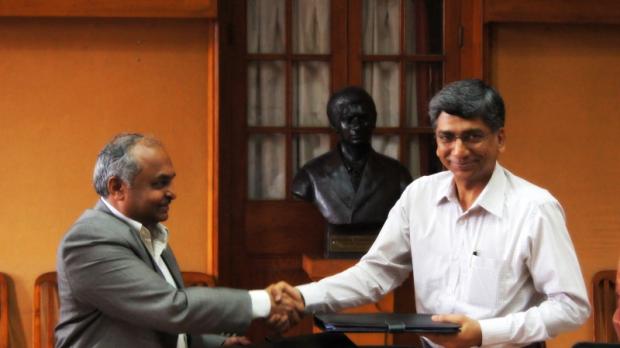
Prof. Anurag Kumar exchanging the agreement with Dr. Ajit Kalghatgi. Photo Credit: Siddharth Kankaria / Research Matters
In a major move to homegrown research, the Indian Institute of Science, Bangalore, (IISc) and Bharat Electronics Limited (BEL) today signed an agreement on transferring a technology on Radio Frequency (RF) amplifiers based on Complementary Metal Oxide Semiconductor (CMOS) technology, developed at IISc. The signing ceremony took place at IISc where Prof. Anurag Kumar, Director, IISc and Dr. Ajit Kalghatghi, Director (R&D), BEL exchanged the agreement. Prof. Y. Narahari, Divisional Chairperson, Electrical Sciences, gave an overview of the occasion and welcomed representatives from BEL for this occasion.
Prof. Anurag Kumar, who spoke during this event, noted that IISc has been primarily pursuing fundamental research and expanding the boundaries of knowledge. He expressed happiness over this transfer of knowledge to practice and stressed the need for translating knowledge for the benefit of the society. Dr. Ajit Kalghatgi complimented Dr. Gaurab Banerjee, the researcher responsible for this technology, in his speech. He noted how this technology is critical for the self-reliance and aids in import substitution and lauded the efforts of the institute in fostering a proactive industry – academia relationship. He called out the usage of this technology in a variety of applications.
Representing IISc at the event were Mr. V. Rajarajan, Registrar, Prof. KVS Hari, Prof. Navakanta Bhat and Prof. KJ Vinoy along with Mr. Jaideep Chouhan, one of the researchers who worked on this technology and had played a key role. Commander Jagannath from BEL also graced the occasion.
Amplifiers strengthen electronic signals. They increase the volume in a sound system and strengthen the received radio signal in a mobile phone. Wideband RF amplifiers work over a large frequency range, and are widely used in industrial and defence applications. However, since they are not manufactured in India, they need to be imported. The new RF Amplifiers on CMOS developed by Dr. Gaurab Banerjee and his team for the first time in India, has significant strategic applications. According to the researchers, the new amplifiers outperform the imported ones in efficiency and size.
Their amplifier design consumes 90% less power, and occupies 50% less space than those that are imported. While this design is manufactured using a semiconductor “foundry”, since these are designed in India, they can save a lot of money by reducing imports. Once semiconductor manufacturing “fabs” are established in India, this design can very easily be moved to indigenous production using those facilities.
The amplifier leverages the industry-standard Complementary Metal Oxide Semiconductor (CMOS) technology. CMOS is used to build complicated integrated circuits with hundreds of thousands of components. For example, microprocessor in your computer, and the image sensor in your camera are manufactured using CMOS. However, as Dr. Gaurab Banerjee says, “[it] has some limitations in strategically important applications”. But the IISc team overcame them by making “some key modifications to a well-established amplifier topology to enable this design on a CMOS process”.
The research has been carried out with support from Department of Electronics and Information Technology (DEITY) now a separate Ministry and Bharat Electronics Limited (BEL), a state-owned aerospace and defence company.





